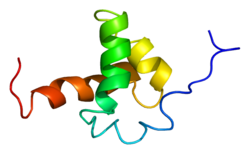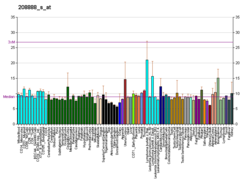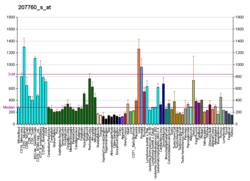Nuclear receptor co-repressor 2
The nuclear receptor co-repressor 2 (NCOR2) is a transcriptional coregulatory protein that contains several nuclear receptor-interacting domains. In addition, NCOR2 appears to recruit histone deacetylases to DNA promoter regions. Hence NCOR2 assists nuclear receptors in the down regulation of target gene expression.[5][6] NCOR2 is also referred to as a silencing mediator for retinoid or thyroid-hormone receptors (SMRT)[5] or T3 receptor-associating cofactor 1 (TRAC-1).[6]
Function[edit]
NCOR2/SMRT is a transcriptional coregulatory protein that contains several modulatory functional domains including multiple autonomous repression domains as well as two or three C-terminal nuclear receptor-interacting domains.[5] NCOR2/SMRT serves as a repressive coregulatory factor (corepressor) for multiple transcription factor pathways. In this regard, NCOR2/SMRT functions as a platform protein, facilitating the recruitment of histone deacetylases to the DNA promoters bound by its interacting transcription factors.[7]
Family[edit]
It is a member of the family of nuclear receptor corepressors; the other human protein that is a member of that family is Nuclear receptor co-repressor 1.[8]
Discovery[edit]
SMRT was initially cloned and characterized in the laboratory of Dr. Ronald M. Evans at the Salk Institute for Biological Studies.[5] In another early investigation into this molecule, similar findings were reported in a variant referred to as TRAC-1.[6]
Interactions[edit]
Nuclear receptor co-repressor 2 has been shown to interact with:
- AR,[9][10][11]
- BCL6,[12][13][14]
- C-Fos,[15]
- C-jun,[15]
- HDAC1,[16][17]
- HDAC3,[17][18][19][20][21][22][23]
- HDAC4,[22][24]
- HDAC5,[24]
- HDAC10,[16]
- MeCP2,[25]
- NR4A1,[26]
- POU2F1,[27]
- PPARD,[28]
- PGR,[29]
- PML[30][31]
- RBPJ,[32][33]
- RELA,[15][34]
- RUNX1T1,[35][36]
- RARA,[37][38]
- SIN3A,[18][24]
- SNW1,[39][40]
- SPEN,[41]
- SRF,[15]
- TBL1X,[18][19][20][21]
- THRB,[42][43][44]
- VDR,[43][45] and
- ZBTB16.[12][35][38]
References[edit]
- ^ a b c GRCh38: Ensembl release 89: ENSG00000196498 – Ensembl, May 2017
- ^ a b c GRCm38: Ensembl release 89: ENSMUSG00000029478 – Ensembl, May 2017
- ^ "Human PubMed Reference:". National Center for Biotechnology Information, U.S. National Library of Medicine.
- ^ "Mouse PubMed Reference:". National Center for Biotechnology Information, U.S. National Library of Medicine.
- ^ a b c d Chen JD, Evans RM (October 1995). "A transcriptional co-repressor that interacts with nuclear hormone receptors". Nature. 377 (6548): 454–7. Bibcode:1995Natur.377..454C. doi:10.1038/377454a0. PMID 7566127. S2CID 4361329.
- ^ a b c Sande S, Privalsky ML (July 1996). "Identification of TRACs (T3 receptor-associating cofactors), a family of cofactors that associate with, and modulate the activity of, nuclear hormone receptors". Molecular Endocrinology. 10 (7): 813–25. doi:10.1210/mend.10.7.8813722. PMID 8813722.
- ^ Nagy L, Kao HY, Chakravarti D, Lin RJ, Hassig CA, Ayer DE, Schreiber SL, Evans RM (May 1997). "Nuclear receptor repression mediated by a complex containing SMRT, mSin3A, and histone deacetylase". Cell. 89 (3): 373–80. doi:10.1016/S0092-8674(00)80218-4. PMID 9150137. S2CID 14686941.
- ^ UniProt Nuclear receptor corepressors family Page accessed June 26, 2016
- ^ Liao G, Chen LY, Zhang A, Godavarthy A, Xia F, Ghosh JC, Li H, Chen JD (February 2003). "Regulation of androgen receptor activity by the nuclear receptor corepressor SMRT". The Journal of Biological Chemistry. 278 (7): 5052–61. doi:10.1074/jbc.M206374200. PMID 12441355.
- ^ Song LN, Coghlan M, Gelmann EP (January 2004). "Antiandrogen effects of mifepristone on coactivator and corepressor interactions with the androgen receptor". Molecular Endocrinology. 18 (1): 70–85. doi:10.1210/me.2003-0189. PMID 14593076.
- ^ Dotzlaw H, Moehren U, Mink S, Cato AC, Iñiguez Lluhí JA, Baniahmad A (April 2002). "The amino terminus of the human AR is target for corepressor action and antihormone agonism". Molecular Endocrinology. 16 (4): 661–73. doi:10.1210/me.16.4.661. PMID 11923464.
- ^ a b Wong CW, Privalsky ML (October 1998). "Components of the SMRT corepressor complex exhibit distinctive interactions with the POZ domain oncoproteins PLZF, PLZF-RARalpha, and BCL-6". The Journal of Biological Chemistry. 273 (42): 27695–702. doi:10.1074/jbc.273.42.27695. PMID 9765306.
- ^ Huynh KD, Fischle W, Verdin E, Bardwell VJ (July 2000). "BCoR, a novel corepressor involved in BCL-6 repression". Genes & Development. 14 (14): 1810–23. doi:10.1101/gad.14.14.1810. PMC 316791. PMID 10898795.
- ^ Deltour S, Guerardel C, Leprince D (December 1999). "Recruitment of SMRT/N-CoR-mSin3A-HDAC-repressing complexes is not a general mechanism for BTB/POZ transcriptional repressors: the case of HIC-1 and gammaFBP-B". Proceedings of the National Academy of Sciences of the United States of America. 96 (26): 14831–6. Bibcode:1999PNAS...9614831D. doi:10.1073/pnas.96.26.14831. PMC 24733. PMID 10611298.
- ^ a b c d Lee SK, Kim JH, Lee YC, Cheong J, Lee JW (April 2000). "Silencing mediator of retinoic acid and thyroid hormone receptors, as a novel transcriptional corepressor molecule of activating protein-1, nuclear factor-kappaB, and serum response factor". The Journal of Biological Chemistry. 275 (17): 12470–4. doi:10.1074/jbc.275.17.12470. PMID 10777532.
- ^ a b Fischer DD, Cai R, Bhatia U, Asselbergs FA, Song C, Terry R, Trogani N, Widmer R, Atadja P, Cohen D (February 2002). "Isolation and characterization of a novel class II histone deacetylase, HDAC10". The Journal of Biological Chemistry. 277 (8): 6656–66. doi:10.1074/jbc.M108055200. PMID 11739383.
- ^ a b Underhill C, Qutob MS, Yee SP, Torchia J (December 2000). "A novel nuclear receptor corepressor complex, N-CoR, contains components of the mammalian SWI/SNF complex and the corepressor KAP-1". The Journal of Biological Chemistry. 275 (51): 40463–70. doi:10.1074/jbc.M007864200. PMID 11013263.
- ^ a b c Li J, Wang J, Wang J, Nawaz Z, Liu JM, Qin J, Wong J (August 2000). "Both corepressor proteins SMRT and N-CoR exist in large protein complexes containing HDAC3". The EMBO Journal. 19 (16): 4342–50. doi:10.1093/emboj/19.16.4342. PMC 302030. PMID 10944117.
- ^ a b Yoon HG, Chan DW, Huang ZQ, Li J, Fondell JD, Qin J, Wong J (March 2003). "Purification and functional characterization of the human N-CoR complex: the roles of HDAC3, TBL1 and TBLR1". The EMBO Journal. 22 (6): 1336–46. doi:10.1093/emboj/cdg120. PMC 151047. PMID 12628926.
- ^ a b Guenther MG, Yu J, Kao GD, Yen TJ, Lazar MA (December 2002). "Assembly of the SMRT-histone deacetylase 3 repression complex requires the TCP-1 ring complex". Genes & Development. 16 (24): 3130–5. doi:10.1101/gad.1037502. PMC 187500. PMID 12502735.
- ^ a b Guenther MG, Lane WS, Fischle W, Verdin E, Lazar MA, Shiekhattar R (May 2000). "A core SMRT corepressor complex containing HDAC3 and TBL1, a WD40-repeat protein linked to deafness". Genes & Development. 14 (9): 1048–57. doi:10.1101/gad.14.9.1048. PMC 316569. PMID 10809664.
- ^ a b Fischle W, Dequiedt F, Hendzel MJ, Guenther MG, Lazar MA, Voelter W, Verdin E (January 2002). "Enzymatic activity associated with class II HDACs is dependent on a multiprotein complex containing HDAC3 and SMRT/N-CoR". Molecular Cell. 9 (1): 45–57. doi:10.1016/S1097-2765(01)00429-4. hdl:11858/00-001M-0000-002C-9FF9-9. PMID 11804585.
- ^ Yoon HG, Chan DW, Reynolds AB, Qin J, Wong J (September 2003). "N-CoR mediates DNA methylation-dependent repression through a methyl CpG binding protein Kaiso". Molecular Cell. 12 (3): 723–34. doi:10.1016/j.molcel.2003.08.008. PMID 14527417.
- ^ a b c Huang EY, Zhang J, Miska EA, Guenther MG, Kouzarides T, Lazar MA (January 2000). "Nuclear receptor corepressors partner with class II histone deacetylases in a Sin3-independent repression pathway". Genes & Development. 14 (1): 45–54. doi:10.1101/gad.14.1.45. PMC 316335. PMID 10640275.
- ^ Lyst MJ, Ekiert R, Ebert DH, Merusi C, Nowak J, Selfridge J, Guy J, Kastan NR, Robinson ND, de Lima Alves F, Rappsilber J, Greenberg ME, Bird A (July 2013). "Rett syndrome mutations abolish the interaction of MeCP2 with the NCoR/SMRT co-repressor". Nature Neuroscience. 16 (7): 898–902. doi:10.1038/nn.3434. PMC 3786392. PMID 23770565.
- ^ Sohn YC, Kwak E, Na Y, Lee JW, Lee SK (November 2001). "Silencing mediator of retinoid and thyroid hormone receptors and activating signal cointegrator-2 as transcriptional coregulators of the orphan nuclear receptor Nur77". The Journal of Biological Chemistry. 276 (47): 43734–9. doi:10.1074/jbc.M107208200. PMID 11559707.
- ^ Kakizawa T, Miyamoto T, Ichikawa K, Takeda T, Suzuki S, Mori J, Kumagai M, Yamashita K, Hashizume K (March 2001). "Silencing mediator for retinoid and thyroid hormone receptors interacts with octamer transcription factor-1 and acts as a transcriptional repressor". The Journal of Biological Chemistry. 276 (13): 9720–5. doi:10.1074/jbc.M008531200. PMID 11134019.
- ^ Shi Y, Hon M, Evans RM (March 2002). "The peroxisome proliferator-activated receptor delta, an integrator of transcriptional repression and nuclear receptor signaling". Proceedings of the National Academy of Sciences of the United States of America. 99 (5): 2613–8. Bibcode:2002PNAS...99.2613S. doi:10.1073/pnas.052707099. PMC 122396. PMID 11867749.
- ^ Giangrande PH, Kimbrel EA, Edwards DP, McDonnell DP (May 2000). "The opposing transcriptional activities of the two isoforms of the human progesterone receptor are due to differential cofactor binding". Molecular and Cellular Biology. 20 (9): 3102–15. doi:10.1128/MCB.20.9.3102-3115.2000. PMC 85605. PMID 10757795.
- ^ Khan MM, Nomura T, Kim H, Kaul SC, Wadhwa R, Shinagawa T, Ichikawa-Iwata E, Zhong S, Pandolfi PP, Ishii S (June 2001). "Role of PML and PML-RARalpha in Mad-mediated transcriptional repression". Molecular Cell. 7 (6): 1233–43. doi:10.1016/S1097-2765(01)00257-X. PMID 11430826.
- ^ Hong SH, Yang Z, Privalsky ML (November 2001). "Arsenic trioxide is a potent inhibitor of the interaction of SMRT corepressor with Its transcription factor partners, including the PML-retinoic acid receptor alpha oncoprotein found in human acute promyelocytic leukemia". Molecular and Cellular Biology. 21 (21): 7172–82. doi:10.1128/MCB.21.21.7172-7182.2001. PMC 99892. PMID 11585900.
- ^ Beatus P, Lundkvist J, Oberg C, Pedersen K, Lendahl U (June 2001). "The origin of the ankyrin repeat region in Notch intracellular domains is critical for regulation of HES promoter activity". Mechanisms of Development. 104 (1–2): 3–20. doi:10.1016/S0925-4773(01)00373-2. PMID 11404076. S2CID 9526831.
- ^ Zhou S, Hayward SD (September 2001). "Nuclear localization of CBF1 is regulated by interactions with the SMRT corepressor complex". Molecular and Cellular Biology. 21 (18): 6222–32. doi:10.1128/MCB.21.18.6222-6232.2001. PMC 87339. PMID 11509665.
- ^ Espinosa L, Inglés-Esteve J, Robert-Moreno A, Bigas A (February 2003). "IkappaBalpha and p65 regulate the cytoplasmic shuttling of nuclear corepressors: cross-talk between Notch and NFkappaB pathways". Molecular Biology of the Cell. 14 (2): 491–502. doi:10.1091/mbc.E02-07-0404. PMC 149987. PMID 12589049.
- ^ a b Takahashi S, McConnell MJ, Harigae H, Kaku M, Sasaki T, Melnick AM, Licht JD (June 2004). "The Flt3 internal tandem duplication mutant inhibits the function of transcriptional repressors by blocking interactions with SMRT". Blood. 103 (12): 4650–8. doi:10.1182/blood-2003-08-2759. PMID 14982881.
- ^ Zhang J, Hug BA, Huang EY, Chen CW, Gelmetti V, Maccarana M, Minucci S, Pelicci PG, Lazar MA (January 2001). "Oligomerization of ETO is obligatory for corepressor interaction". Molecular and Cellular Biology. 21 (1): 156–63. doi:10.1128/MCB.21.1.156-163.2001. PMC 88789. PMID 11113190.
- ^ Dong S, Tweardy DJ (April 2002). "Interactions of STAT5b-RARalpha, a novel acute promyelocytic leukemia fusion protein, with retinoic acid receptor and STAT3 signaling pathways". Blood. 99 (8): 2637–46. doi:10.1182/blood.V99.8.2637. PMID 11929748.
- ^ a b Hong SH, David G, Wong CW, Dejean A, Privalsky ML (August 1997). "SMRT corepressor interacts with PLZF and with the PML-retinoic acid receptor alpha (RARalpha) and PLZF-RARalpha oncoproteins associated with acute promyelocytic leukemia". Proceedings of the National Academy of Sciences of the United States of America. 94 (17): 9028–33. Bibcode:1997PNAS...94.9028H. doi:10.1073/pnas.94.17.9028. PMC 23013. PMID 9256429.
- ^ Zhou S, Fujimuro M, Hsieh JJ, Chen L, Hayward SD (February 2000). "A role for SKIP in EBNA2 activation of CBF1-repressed promoters". Journal of Virology. 74 (4): 1939–47. doi:10.1128/JVI.74.4.1939-1947.2000. PMC 111672. PMID 10644367.
- ^ Zhou S, Fujimuro M, Hsieh JJ, Chen L, Miyamoto A, Weinmaster G, Hayward SD (April 2000). "SKIP, a CBF1-associated protein, interacts with the ankyrin repeat domain of NotchIC To facilitate NotchIC function". Molecular and Cellular Biology. 20 (7): 2400–10. doi:10.1128/MCB.20.7.2400-2410.2000. PMC 85419. PMID 10713164.
- ^ Shi Y, Downes M, Xie W, Kao HY, Ordentlich P, Tsai CC, Hon M, Evans RM (May 2001). "Sharp, an inducible cofactor that integrates nuclear receptor repression and activation". Genes & Development. 15 (9): 1140–51. doi:10.1101/gad.871201. PMC 312688. PMID 11331609.
- ^ Liu Y, Takeshita A, Misiti S, Chin WW, Yen PM (October 1998). "Lack of coactivator interaction can be a mechanism for dominant negative activity by mutant thyroid hormone receptors". Endocrinology. 139 (10): 4197–204. doi:10.1210/endo.139.10.6218. PMID 9751500.
- ^ a b Tagami T, Lutz WH, Kumar R, Jameson JL (December 1998). "The interaction of the vitamin D receptor with nuclear receptor corepressors and coactivators". Biochemical and Biophysical Research Communications. 253 (2): 358–63. doi:10.1006/bbrc.1998.9799. PMID 9878542.
- ^ Ando S, Sarlis NJ, Krishnan J, Feng X, Refetoff S, Zhang MQ, Oldfield EH, Yen PM (September 2001). "Aberrant alternative splicing of thyroid hormone receptor in a TSH-secreting pituitary tumor is a mechanism for hormone resistance". Molecular Endocrinology. 15 (9): 1529–38. doi:10.1210/mend.15.9.0687. PMID 11518802.
- ^ Puccetti E, Obradovic D, Beissert T, Bianchini A, Washburn B, Chiaradonna F, Boehrer S, Hoelzer D, Ottmann OG, Pelicci PG, Nervi C, Ruthardt M (December 2002). "AML-associated translocation products block vitamin D(3)-induced differentiation by sequestering the vitamin D(3) receptor". Cancer Research. 62 (23): 7050–8. PMID 12460926.
Further reading[edit]
- Hörlein AJ, Näär AM, Heinzel T, Torchia J, Gloss B, Kurokawa R, Ryan A, Kamei Y, Söderström M, Glass CK (October 1995). "Ligand-independent repression by the thyroid hormone receptor mediated by a nuclear receptor co-repressor". Nature. 377 (6548): 397–404. Bibcode:1995Natur.377..397H. doi:10.1038/377397a0. PMID 7566114. S2CID 4230850.
- Chen JD, Evans RM (October 1995). "A transcriptional co-repressor that interacts with nuclear hormone receptors". Nature. 377 (6548): 454–7. Bibcode:1995Natur.377..454C. doi:10.1038/377454a0. PMID 7566127. S2CID 4361329.
- Sande S, Privalsky ML (July 1996). "Identification of TRACs (T3 receptor-associating cofactors), a family of cofactors that associate with, and modulate the activity of, nuclear hormone receptors". Molecular Endocrinology. 10 (7): 813–25. doi:10.1210/mend.10.7.8813722. PMID 8813722.
- Bonaldo MF, Lennon G, Soares MB (September 1996). "Normalization and subtraction: two approaches to facilitate gene discovery". Genome Research. 6 (9): 791–806. doi:10.1101/gr.6.9.791. PMID 8889548.
- Margolis RL, Abraham MR, Gatchell SB, Li SH, Kidwai AS, Breschel TS, Stine OC, Callahan C, McInnis MG, Ross CA (July 1997). "cDNAs with long CAG trinucleotide repeats from human brain". Human Genetics. 100 (1): 114–22. doi:10.1007/s004390050476. PMID 9225980. S2CID 25999127.
- Hong SH, David G, Wong CW, Dejean A, Privalsky ML (August 1997). "SMRT corepressor interacts with PLZF and with the PML-retinoic acid receptor alpha (RARalpha) and PLZF-RARalpha oncoproteins associated with acute promyelocytic leukemia". Proceedings of the National Academy of Sciences of the United States of America. 94 (17): 9028–33. Bibcode:1997PNAS...94.9028H. doi:10.1073/pnas.94.17.9028. PMC 23013. PMID 9256429.
- Chen H, Lin RJ, Schiltz RL, Chakravarti D, Nash A, Nagy L, Privalsky ML, Nakatani Y, Evans RM (August 1997). "Nuclear receptor coactivator ACTR is a novel histone acetyltransferase and forms a multimeric activation complex with P/CAF and CBP/p300". Cell. 90 (3): 569–80. doi:10.1016/S0092-8674(00)80516-4. PMID 9267036. S2CID 15284825.
- Lin RJ, Nagy L, Inoue S, Shao W, Miller WH, Evans RM (February 1998). "Role of the histone deacetylase complex in acute promyelocytic leukaemia". Nature. 391 (6669): 811–4. Bibcode:1998Natur.391..811L. doi:10.1038/35895. PMID 9486654. S2CID 4383951.
- Laherty CD, Billin AN, Lavinsky RM, Yochum GS, Bush AC, Sun JM, Mullen TM, Davie JR, Rose DW, Glass CK, Rosenfeld MG, Ayer DE, Eisenman RN (July 1998). "SAP30, a component of the mSin3 corepressor complex involved in N-CoR-mediated repression by specific transcription factors". Molecular Cell. 2 (1): 33–42. doi:10.1016/S1097-2765(00)80111-2. PMID 9702189.
- Liu Y, Takeshita A, Misiti S, Chin WW, Yen PM (October 1998). "Lack of coactivator interaction can be a mechanism for dominant negative activity by mutant thyroid hormone receptors". Endocrinology. 139 (10): 4197–204. doi:10.1210/endo.139.10.6218. PMID 9751500.
- Wong CW, Privalsky ML (October 1998). "Components of the SMRT corepressor complex exhibit distinctive interactions with the POZ domain oncoproteins PLZF, PLZF-RARalpha, and BCL-6". The Journal of Biological Chemistry. 273 (42): 27695–702. doi:10.1074/jbc.273.42.27695. PMID 9765306.
- Ordentlich P, Downes M, Xie W, Genin A, Spinner NB, Evans RM (March 1999). "Unique forms of human and mouse nuclear receptor corepressor SMRT". Proceedings of the National Academy of Sciences of the United States of America. 96 (6): 2639–44. Bibcode:1999PNAS...96.2639O. doi:10.1073/pnas.96.6.2639. PMC 15821. PMID 10077563.
- Park EJ, Schroen DJ, Yang M, Li H, Li L, Chen JD (March 1999). "SMRTe, a silencing mediator for retinoid and thyroid hormone receptors-extended isoform that is more related to the nuclear receptor corepressor". Proceedings of the National Academy of Sciences of the United States of America. 96 (7): 3519–24. Bibcode:1999PNAS...96.3519P. doi:10.1073/pnas.96.7.3519. PMC 22325. PMID 10097068.
- Nguyen TA, Hoivik D, Lee JE, Safe S (July 1999). "Interactions of nuclear receptor coactivator/corepressor proteins with the aryl hydrocarbon receptor complex". Archives of Biochemistry and Biophysics. 367 (2): 250–7. doi:10.1006/abbi.1999.1282. PMID 10395741.
- Bailey P, Downes M, Lau P, Harris J, Chen SL, Hamamori Y, Sartorelli V, Muscat GE (July 1999). "The nuclear receptor corepressor N-CoR regulates differentiation: N-CoR directly interacts with MyoD". Molecular Endocrinology. 13 (7): 1155–68. doi:10.1210/mend.13.7.0305. PMID 10406466.
- Kao HY, Downes M, Ordentlich P, Evans RM (January 2000). "Isolation of a novel histone deacetylase reveals that class I and class II deacetylases promote SMRT-mediated repression". Genes & Development. 14 (1): 55–66. doi:10.1101/gad.14.1.55. PMC 316336. PMID 10640276.
- Zhou S, Fujimuro M, Hsieh JJ, Chen L, Miyamoto A, Weinmaster G, Hayward SD (April 2000). "SKIP, a CBF1-associated protein, interacts with the ankyrin repeat domain of NotchIC To facilitate NotchIC function". Molecular and Cellular Biology. 20 (7): 2400–10. doi:10.1128/MCB.20.7.2400-2410.2000. PMC 85419. PMID 10713164.
- Lee SK, Kim JH, Lee YC, Cheong J, Lee JW (April 2000). "Silencing mediator of retinoic acid and thyroid hormone receptors, as a novel transcriptional corepressor molecule of activating protein-1, nuclear factor-kappaB, and serum response factor". The Journal of Biological Chemistry. 275 (17): 12470–4. doi:10.1074/jbc.275.17.12470. PMID 10777532.
- Guenther MG, Lane WS, Fischle W, Verdin E, Lazar MA, Shiekhattar R (May 2000). "A core SMRT corepressor complex containing HDAC3 and TBL1, a WD40-repeat protein linked to deafness". Genes & Development. 14 (9): 1048–57. doi:10.1101/gad.14.9.1048. PMC 316569. PMID 10809664.
- Grozinger CM, Schreiber SL (July 2000). "Regulation of histone deacetylase 4 and 5 and transcriptional activity by 14-3-3-dependent cellular localization". Proceedings of the National Academy of Sciences of the United States of America. 97 (14): 7835–40. Bibcode:2000PNAS...97.7835G. doi:10.1073/pnas.140199597. PMC 16631. PMID 10869435.
External links[edit]
- nuclear receptor corepressor 2 at the U.S. National Library of Medicine Medical Subject Headings (MeSH)
- NURSA C98









